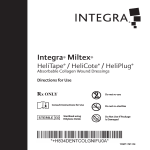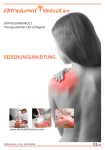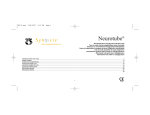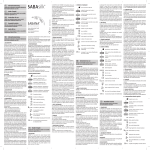Download GB Instructions for use H Használati utasítás
Transcript
D F Gebrauchsanweisung Matériel de suture chirurgical stérile résorbable Combinaison aiguille-fil en acide polyglycolique (PGA) Steriles resorbierbares chirurgisches Nahtmaterial Nadel-Faden-Kombination aus Polyglykolsäure (PGA) F Mode d’emploi 1. DESCRIPTION Matériel de suture chirurgical stérile résorbable Combinaison aiguille-fil en acide polyglycolique (PGA) Instructions for use Stand: 03/2012 Sterile, absorbable surgical suture material Needle-suture combination made of polyglycolic acid (PGA) Használati utasítás Steril felszívódó sebészeti varróanyag Tű-fonal kombináció poliglikolsav alapanyagból (PGA) I Guida all’uso Materiale di sutura chirurgico sterile riassorbibile Combinazione ago-filo in acido poliglicolide (PGA) Sabana Medizinbedarf GmbH Alwinenstraße 2 65189 Wiesbaden/Germany www.sabana.de 0123 H Mode d’emploi Gebrauchsanweisung Steriles resorbierbares chirurgisches Nahtmaterial Nadel-Faden-Kombination aus Polyglykolsäure (PGA) 1. BESCHREIBUNG SABAsorb ist ein geflochtenes und beschichtetes (Polycarprolakton und Kalziumstereat) synthetisches resorbierbares Nahtmaterial aus dem Polymer der Glykolsäure (Polyglykolsäure – PGA). Die für PGA-Fäden typischen Eigenschaften sind die hohe Ausgangsreißfestigkeit, die Geschmeidigkeit sowie die hervorragenden Knoteigenschaften. SABAsorb® ist ungefärbt oder mit physiologisch unbedenklichem Farbstoff violett eingefärbt lieferbar. SABAsorb® ist in verschiedenen Fadenstärken und -längen mit fest armierten chirurgischen Nadeln unterschiedlicher Typen und Durchmesser erhältlich. Die Verpackung von PGA-Nahtmaterial ist violett gekennzeichnet. SABAsorb® erfüllt die strengen Anforderungen des Euro päischen Arzneimittelbuchs und der EG-Richtlinie 93/42/EWG über Medizinprodukte. ® 2. ANWENDUNGSGEBIETE SABAsorb® ist vorgesehen für die Adaptation von Weichgewebe und/oder Ligatur, einschließlich der Ophthalmologie, der Anastomose peripherer Nerven und in der Mikrochirurgie für Gefäße von weniger als 2 mm Durchmesser. Anwendung Das zu verwendende Nahtmaterial ist unter Berücksichtigung des Zustands des Patienten und der Größe der Wunde auszuwählen. Materialverhalten Resorbierbares Nahtmaterial löst eine anfängliche entzündliche Gewebereaktion und wächst in faseriges Nervengewebe ein. Die Auflösung des PGA-Fadenmaterials im Gewebe erfolgt durch Hydrolyse (Wasseraufnahme in Umkehrung der Synthese). Die Reißfestigkeit des Fadens liegt zwei Wochen nach dem Eingriff bei etwa 65% des Ausgangswerts. Die Resorption ist nach 60 bis 90 Tagen weitestgehend abgeschlossen. 3. GEGENANZEIGEN SABAsorb® ist nicht geeignet für die kardiovaskuläre Anwendung sowie für den Einsatz bei neuralem Gewebe. Es darf außerdem nicht für die Adaption ausgedehnterer Gewebepartien unter Zugspannung verwendet werden. SABAsorb® sollte nicht bei Patienten mit bekannter Überempfindlichkeit oder allergischer Reaktion gegen seine Bestandteile verwendet werden. 4. WARNHINWEISE SABAsorb® ist zum einmaligen Gebrauch bestimmt. Die Nadeln dürfen keinesfalls resterilisiert werden. Die erneute Verwendung kann zu schweren, unter Umständen sogar tödlichen Infektionen des Patienten führen. Entsprechend den gesetzlichen Bestimmungen übernimmt der Hersteller hierfür keine Verantwortung. SABAsorb® darf nicht verwendet werden, • wenn das Verfallsdatum überschritten ist, • die Sterilverpackung beschädigt ist oder • Zweifel an ihrer Unversehrtheit bestehen. SABAsorb® darf nur von Ärzten angewendet werden, die mit der Anwendung resorbierbaren Nahtmaterials vertraut sind, da das Risiko einer Wunddehiszenz vom Anwendungsort und vom verwendeten Nahtmaterial abhängt. Dabei ist das Materialverhalten im Gewebe zu beachten (siehe oben). Darüber hinaus muss der Operateur auch über ausreichende Kenntnisse über das notwendige Handling (z. B. Knotentechniken) verfügen. Der Operateur ist für Komplikationen verantwortlich, die sich aus einer fehlerhaften Indikation, einer unzureichenden Operationstechnik oder einem aseptischen Fehler ergeben. In allen Fällen wird empfohlen, den Eingriff durch entsprechende Nachsorgemaßnahmen zu begleiten. Wie jeder Fremdkörper kann ein längerer Kontakt mit Salzlösungen, wie sie etwa im Harn- und Gallentrakt vorkommen, zur Bildung von Konkrementen führen. Ggf. sollte die Verwendung von zusätzlichem nicht-resorbierbaren Nahtmaterials in Erwägung gezogen werden, wenn im Nahtbereich Gewebedehnungen oder -spannungen auftreten können oder aus die Naht aus anderen Gründen verstärkt werden muss. Wird Nahtmaterial für Hautverschlüsse verwendet, die länger als sieben Tage zur Ausheilung brauchen, kann es zu lokalen Irritationen führen. Es sollte daher bei gegebener Indikation entfernt werden. Unter bestimmten Umständen, insbesondere bei orthopädischen Anwendungen, kann nach Ermessen des Arztes eine Immobilisierung oder externe Unterstützung der betroffenen Gelenke angezeigt sein. Die Verwendung resorbierbaren Nahtmaterials bei schlecht durchblutetem Gewebe kann zu einer Nahtabstoßung und verzögertem Abbau führen. Intrakutannähte sollten so tief wie möglich gelegt werden, um Erytheme und Indurationen, die den Resorptionsprozess üblicherweise begleiten, zu minimieren. SABAsorb® kann bei älteren, unterernährten oder entkräfteten Patienten oder bei Patienten mit schlechter Wundheilung ungeeignet sein. Wie bei jedem anderen Nahtmaterial ist auch bei SABAsorb® darauf zu achten, dass es nicht durch falsche Handhabung beschädigt wird. So hinterlässt das Fassen mit einem Nadelhalter oder einer Klemme deutliche Spuren am Faden. Diese Schädigungen nehmen großen Einfluss auf die Reißfestigkeit eines Fadens. Auch die Handhabung der Nadel darf nur mit angemessener Vorsicht erfolgen. Die Nadel sollte immer am Anfang des letzten Drittels gefasst werden. Das Fassen der Nadel im Nadelspitzenbereich kann die Penetrationswirkung beeinträchtigen und zum Bruch der Nadel führen. Gleiches gilt für das Fassen der Nadel am armierten Ende. Vorsicht auch vor Nadelstichverletzungen! Gebrauchte Nadeln sind sofort nach der Benutzung in einen geeigneten durchstichsicheren Behälter zu entsorgen. 5. NEBENWIRKUNGEN Unerwünschte Nebenwirkungen bei der Anwendung von SABAsorb® können in einer vorübergehenden Gewebeirritation oder einer vorübergehenden entzündlichen Reaktion in der Wundregion, in Erythema und Verhärtungen während des Resorptionsprozesses bei Intrakutannähten bestehen. Wie alle Fremdkörper kann das Nahtmaterial eine vorhandene Infektion verstärken. 6. STERILITÄT SABAsorb® Nadel-Faden-Kombinationen sind mit Ethylenoxid sterilisiert. Es ist nicht zulässig, SABAsorb® zu resterilisieren! Das Produkt darf keinesfalls verwendet werden, wenn die Sterilverpackung beschädigt oder geöffnet ist. Geöffnete, nicht benutzte Produkte unbedingt entsorgen. 7. LAGERBEDINGUNGEN SABAsorb® darf nur bei Temperaturen von unter 25° Celsius und geschützt vor Feuchtigkeit und direkter Hitzeeinwirkung gelagert werden. Nur in der Originalverpackung lagern. Nach Ablauf des Verfallsdatums nicht mehr verwenden. 8. KENNZEICHNUNGSSYMBOLE Name und Anschrift des Herstellers ungefärbtes, geflochtenes, beschichtetes und resorbierbares Nahtmaterial gefärbtes, geflochtenes, beschichtetes und resorbierbares Nahtmaterial Chargenbezeichnung Sterilisiert mit Ethylenoxid Nicht zur Wiederverwendung Nicht erneut sterilisieren Gebrauchsanweisung beachten J J JJ-MM Verwendbar bis (Jahr-Monat) Vor Sonnenlicht geschützt aufbewahren Obere Temperaturbegrenzung für die Lagerung Bei beschädigter Verpackung nicht verwenden 0123 CE-Kennzeichnung mit Kennnummer der Benannten Stelle 5. EFFETS SECONDAIRES SABAsorb® est un matériel de suture tressé et enduit (polycarprolactone et stéarate de calcium) synthétique résorbable réalisé avec le polymère de l’acide glycolique (acide polyglycolique – PGA). Les propriétés typiques des fils PGA sont une grande résistance initiale à la rupture, la souplesse et les excellentes propriétés au niveau de la tenue des nœuds SABAsorb® est disponible non teint ou coloré avec une teinte violette inoffensive, au niveau physiologique. SABAsorb® est disponible dans différentes grosseurs et longueurs de fil avec des aiguilles chirurgicales fixement armées de types et de diamètres différents. L’emballage du matériel de suture PGA est violet. SABAsorb® remplit les exigences sévères de la pharmacopée européenne et de la directive CE 93/42/CEE concernant les dispositifs médicaux. Dans l’utilisation de SABAsorb®, les effets secondaires non souhaités qui surviennent peuvent consister en une irritation passagère du tissu ou en une réaction inflammatoire passagère dans la zone de la plaie, dans le cas des sutures intradermiques il peut s’agir d’érythème et de durcissements pendant le processus de résorption. Comme tous les corps étrangers, le matériel de suture peut aggraver une infection existante. 2. DOMAINES D’UTILISATION SABAsorb est prévu pour l’adaptation et/ou la ligature de tissus mous, y compris en ophtalmologie, dans l’anastomose de nerfs périphériques et en microchirurgie pour des vaisseaux de moins de 2 mm de diamètre. SABAsorb® doit être stocké uniquement à des températures de moins de 25° Celsius et il faut le protéger de l’humidité et de l’effet direct de la chaleur. A conserver uniquement dans l’emballage original. Ne plus utiliser après expiration de la date de péremption. UTILISATION 8. SYMBOLES DE MARQUAGE ® D Attention également aux blessures par piqûres d’aiguille! Après utilisation, il faut immédiatement éliminer les aiguilles usagées dans des contenants spéciaux destinés à recevoir les aiguilles et les objets tranchants ou pointus. Le matériel de suture à utiliser doit être choisi en fonction de l’état du patient et de la taille de la plaie. 6. STÉRILITÉ Les combinaisons d’aiguille et de fil SABAsorb® sont stérilisées à l’oxyde d’éthylène. Il est interdit de restériliser SABAsorb®! Le produit ne peut en aucun cas être utilisé si l’emballage stérile est endommagé ou ouvert. Il faut absolument éliminer les produits ouverts non utilisés. 7. CONDITIONS DE STOCKAGE Nom et adresse du fabricant COMPORTEMENT DU MATERIAU Le matériel de suture déclenche une réaction initiale d’inflammation du tissu et s’incarne ensuite dans le tissu nerveux fibreux. La résorption du matériel de suture PGA se fait par hydrolyse (scission par réaction avec l’eau). Environ deux semaines après l’intervention, la résistance du fil à la rupture est à peu près de 65% de la valeur initiale. Au bout de 60 à 90 jours, la résorption est grandement achevée. matériel de suture non teint, tressé, enduit et résorbable 3. CONTRE-INDICATIONS stérilisé à l’oxyde d’éthylène SABAsorb ne convient pas pour une utilisation cardiovasculaire ni pour un emploi dans le tissu neural. En outre, il ne doit pas être utilisé pour l’adaptation de parties étendue de tissu sous effort de traction. Il ne faut pas utiliser SABAsorb® chez des patients présentant une hypersensibilité ou une réaction allergique connue à ses composants. matériel de suture teint, tressé, enduit et résorbable désignation du lot ® 4. MISES EN GARDE PARTICULIÈRES SABAsorb® est destiné à un usage unique. Il ne faut jamais restériliser les aiguilles. Une réutilisation peut entraîner de graves infections du patient, voire des infections mortelles. Conformément aux dispositions légales, le fabricant décline toute responsabilité à cet égard. Il ne faut pas utiliser SABAsorb®, • quand la date de péremption est dépassée • quand l’emballage stérile est endommagé ou • s’il y a des doutes quant à l’intégralité de l’emballage. SABAsorb® ne peut être utilisé que par des médecins qui connaissent bien l’utilisation de matériel de suture résorbable, puisque le risque de déhiscence de plaie dépend de l’endroit de l’utilisation et du matériel de suture utilisé. Il faut tenir compte du comportement du matériau dans le tissu (cf. plus haut). En outre, le chirurgien doit disposer de connaissances suffisantes sur la manipulation nécessaire (p.ex. techniques de nœuds). Le chirurgien est responsable des complications résultant d’une indication erronée, d’une technique opératoire insuffisante ou d’une erreur stérile. En tous cas, on recommande d’accompagner l’opération de mesures de suivi correspondantes. Comme tout corps étranger, un contact prolongé avec des solutions salées – comme c’est le cas dans les voies urinaires et biliaires, peut entraîner la formation de concrétions. Le cas échéant, il faut envisager d’utiliser du matériel de suture supplémentaire non-résorbable, quand des dilatations ou des tensions du tissu peuvent survenir dans la zone de la suture ou s’il faut renforcer la suture pour d’autres raisons. Si on utilise du matériel de suture pour les fermetures cutanées qui nécessitent plus de sept jours pour guérir complètement, il peut y avoir des irritations locales. En cas d’indication, il faut donc retirer le fil de suture. Dans certaines circonstances, en particulier en cas d’applications orthopédiques, selon l’appréciation du médecin, une immobilisation des articulations concernées peut être indiquée. En cas de tissu mal irrigué, l’utilisation de matériel de suture résorbable peut entraîner un rejet de la suture et un retard de résorption. Pour minimiser les érythèmes et les indurations qui accompagnent habituellement le processus de résorption il faut faire les sutures intradermiques le plus profond possible,. SABAsorb® peut être inadapté pour les patients âgés, sousalimentés ou épuisés ou chez les patients présentant une mauvaise cicatrisation. Dans l’utilisation de SABAsorb®, comme dans l’utilisation de tout autre matériel de suture, il faut veiller à ne pas endommager le matériel par fausse manipulation. La saisie du fil avec un porte-aiguille ou une pince laisse des traces distinctes sur le fil. Ces dégradations ont une grande influence sur la résistance d’un fil à la rupture. Il faut également manier l’aiguille avec la précaution adéquate. C’est toujours uniquement au début du dernier tiers qu’il faut tenir l’aiguille. Quand on tient l’aiguille dans la zone de la pointe, cela peut altérer l’effet de pénétration et entraîner la rupture de l’aiguille. La même chose vaut pour la saisie de l’aiguille par son bout armé. ne pas réutiliser ne pas stériliser à nouveau tenir compte du mode d’emploi JJJ J-MM à utiliser d’ici (année- mois) conserver à l’abri de la lumière du soleil température maximale de stockage ne pas utiliser en cas d’emballage endommagé marquage CE avec numéro d’indentification 0123 du service accrédité 4. WARNINGS SABAsorb® is intended for single use only. The needles may not be resterilized under any circumstances. Re-use can lead to severe and possibly fatal infections in patients. In accordance with statutory provisions, the manufacturer is not liable for this. SABAsorb® may not be used • if the expiration date is in the past, • the sterile packaging is damaged or • if there is doubt as to whether it is intact. SABAsorb® may be used only by physicians who are familiar with the use of absorbable suture material, as the risk of wound dehiscence depends on the site where the sutures are used and on the suture material used. The material behavior in the tissue must be considered thereby (see above). In addition, the surgeon must have sufficient knowledge of the handling required (e.g. knotting techniques). The surgeon is responsible for complications resulting from an incorrect indication, inadequate surgical techniques or an aseptic error. In all cases it is recommended that the surgery be accompanied by corresponding after-care measures. Like any foreign body, longer contact with saline solutions such as those in the urinary and biliary tracts, can result in the formation of concrements. If necessary, the use of additional non-absorbable suture material should be considered if tissue elongation or tension can occur in the sutured area or the suture needs to be reinforced for other reasons. If suture material is used for skin closures that require more than seven days to heal, local irritation can occur. It should therefore be removed when indicated. Under certain circumstances, particularly in orthopedic applications, immobilization of the affected joints may be indicated at the discretion of the physician. The use of absorbable suture material in poorly perfused tissue can result in rejection of the suture and delayed degradation. Intracutaneous sutures should be laid as deep as possible to minimize the erythema and indurations that usually accompany the absorption process. SABAsorb® may be unsuitable for elderly, undernourished or weak patients or patients with poor wound healing. As with any other suture material, care must be taken with SABAsorb® to ensure that it is not damaged by incorrect handling. Thus, gripping it with a needle holder or a clamp leaves clear marks on the suture. Such damage has a strong influence on the stability of a suture. The needle must also be handled with the appropriate care. The needle should always be grasped at the beginning of the last third. Grasping the needle at its point can impair penetration and result in breakage of the needle. The same applies to grasping the needle at the swaged end. Caution must also be exercised with regard to puncture injuries from needles. Used needles must be disposed of in a suitable puncture-proof container immediately after use. 5. SIDE EFFECTS Adverse side effects from the use of SABAsorb® can consist of temporary tissue irritation or a temporary inflammatory reaction in the area of the wound, erythema and indurations during the absorption process with intracutaneous sutures. Like all foreign bodies, the suture material can aggravate an existing infection. 6. STERILITY Instructions for use Sterile, absorbable surgical suture material Needle-suture combination made of polyglycolic acid (PGA) 1. DESCRIPTION SABAsorb® is a woven and coated (polycaprolactone and calcium stearate) synthetic, absorbable suture material made of the polymer of glycolic acid (polyglycolic acid – PGA). The properties typical of PGA sutures are high initial tensile strength, flexibility and the outstanding knotting properties. SABAsorb® suture material is available undyed or dyed violet with physiologically safe dye. SABAsorb® is available in different sizes and lengths with swaged surgical needles of various types and diameters. The packaging of PGA suture material is marked in violet. SABAsorb® meets the strict requirements of the European Pharmacopoeia and the EC Directive 93/42/EEC on medical devices. 2. AREAS OF APPLICATION SABAsorb® is used for the adaptation of soft tissue and/or ligature, including use in ophthalmology, the anastomosis of peripheral nerves and in microsurgery for blood vessels less than 2 mm in diameter. APPLICATION SABAsorb® needle and suture combinations are sterilized with ethylene oxide. Resterilization of SABAsorb® is prohibited! The product must not be used if the sterile packaging is damaged or open. Always dispose of opened, unused products. 7. STORAGE CONDITIONS SABAsorb® must be stored only at temperatures below 25° Celsius and protected from moisture and direct exposure to heat. Store only in the original packaging! Do not use this product after the expiration date! 8. LABELING SYMBOLS Manufacturer’s name and address Undyed, woven, coated and absorbable suture material Dyed, woven, coated and absorbable suture material Batch designation Sterilized with ethylene oxide The suture material to be used must be selected based on the condition of the patient and the size of the wound. Do not re-use. MATERIAL BEHAVIOR Do not resterilize. Absorbable suture material triggers an initial inflammatory tissue response and grows into fibrous nerve tissue. The dissolution of the PGA suture material in the tissue takes place via hydrolysis (splitting due to reaction with water). The tensile strength of the suture two weeks after surgery is approximately 65% of the initial value. Absorption is largely completed after 60 to 90 days. 3. CONTRAINDICATIONS SABAsorb® is not suited for cardiovascular use or for use in neurological tissue. Furthermore, it must not be used for the adaptation of more extensive sections of tissue under tensile stress. SABAsorb® should not be used in patients with known sensitivities or allergies to its components. Comply with the instructions for use. JJJ J-MM Usable until (year-month) Store in a dark location away from sunlight. Upper temperature limit for storage Do not use if the packaging is damaged. CE mark with code number of the Notified 0123 Body H Használati utasítás Steril felszívódó sebészeti varróanyag Tű-fonal kombináció poliglikolsav alapanyagból (PGA) 1. TERMÉKLEÍRÁS A SABAsorb® a glikolsav polimeréből (poliglikolsavból – PGA) készült fonott és bevonatos (polikaprolakton és kálciumsztearát) szintetikus felszívódó varróanyag. A PGA-fonalak tipikus jellemzői közé tartozik a magas kezdeti szakítószilárdság, a kiváló nyújthatósági szilárdság és a kiváló csomózhatóság. A SABAsorb® színtelen vagy fiziológiailag ártalmatlan lila színezékanyaggal színezett kiszerelésben kapható. A SABAsorb® különböző fonalvastagságban és -hosszban, valamint különböző típusú és átmérőjű, fixen a fonalhoz csatlakozó sebészeti tűvel felszerelve kerül forgalomba. A PGA-varróanyag csomagolása lila jelölést visel. A SABAsorb® megfelel az Európai Gyógyszerkönyv és az orvostechnikai eszközökről szóló 93/42/EGK irányelv szigorú követelményeinek. 2. ALKALMAZÁSI TERÜLETEK A SABAsorb® lágy szövetek egyesítésére és/vagy lekötésére, a szemészeti beavatozásokat is ideértve, valamint a perifériás idegek anasztomózisa során és a mikrosebészet terén 2 mm alatti átmérőjű erek varrataihoz alkalmas. ALKALMAZÁS A alkalmazott varróanyag kiválasztásakor a beteg állapotát és a seb méretét kell figyelembe venni. ANYAGVISELKEDÉS A felszívódó varróanyagok kezdetben gyulladásos szövetreakciót váltanak ki és benőnek a rostos idegszövetbe. A PGA alapú fonal hidrolózissel szívódik fel a szövetben (vízzel való reakció általi bomlás). A fonal szakítószilárdsága a beavatkozás utáni két hét elteltével a kezdeti érték kb. 65%-a. A fonal felszívódása 60–90 nap elteltével maradéktalanul végbemegy. 3. ELLENJAVALLATOK A SABAsorb® nem alkalmas a kardiovaszkuláris sebészet területén és az idegszövetben. Emellett nem szabad húzófeszültség alatt álló kiterjedt szövetrészek egyesítésére alkalmazni. A SABAsorb® poliészterrel szemben ismert túlérzékenyéséggel rendelkező vagy arra allergiásan reagáló betegek esetén alkalmazása ellenjavallt. 4. FIGYELMEZTETÉSEK A SABAsorb® egyszeri használatra szánt termék. A tűket tilos újrasterilizálni. Ezek újrafelhasználása súlyos, egyes esetekben akár halálos fertőzést is eredményezhet a betegben. A törvényes rendelkezések értelmében a gyártó ilyen esetekben nem vállal felelősséget. A SABAsorb® nem alkalmazható, ha • lejárt a felhasználási ideje, • nem ép a steril csomagolás vagy • kétség merül fel a csomagolás sértetlenségét illetően. A SABAsorb®-ot csak a felszívódó varróanyagok alkalmazásában jártas orvosok használhatják, mert a varratelégtelenség kockázatának fellépése az alkalmazás helyétől és az alkalmazásra kerülő varróanyagtól függ. Ezt illetően ügyelni kell az anyag szövetben való viselkedésére (lásd fent). A sebésznek emellett megfelelő ismeretekkel kell rendelkeznie a sebészeti eljárások terén (pl. csomózási technikák). A helytelen indikációból, a nem megfelelő sebészeti technika alkalmazásából és az aszepszist gátló hibákból eredő szövődményekért a sebész a felelős. Minden egyes beavatkozás után tanácsos megfelelő utógondozásban részesíteni a beteget. A varrófonalak tartós érintkezése idegen anyaggal, így a húgyutak és az epeutak területén előforduló sóoldatokkal is, kőképződéshez vezethet. Szükség esetén mérlegelni kell nem felszívódó varróanyag kiegészítő alkalmazását is, ha a varrat területén szöveti tágulás vagy szöveti feszültség léphet fel, vagy ha a varratot egyéb okból meg kell erősíteni. A varróanyag hét napon túl gyógyuló bőrzárás céljából történő alkalmazásakor lokális irritáció léphet fel. Ezért a fonalat indokolt esetben el kell távolítani. Bizonyos körülmények között, elsősorban ortopédiai beavatkozások során – az orvos megítélése szerint – tanácsos lehet az érintett ízületek immobilizációja. Felszívódó varróanyag rossz várellátású szövetekben történő alkalmazása varratkilökődéshez vagy a felszívódási idő meghosszabbodásához vezethet. A felszívódási folyamatot általában kísérő erithémaképződés és induráció minimalizálása érdekében az intrakután varratokat a lehető legmélyebben kell elhelyezni. A SABAsorb® alkalmatlannak bizonyulhat idősebb, alultáplált vagy legyengült betegeknél és olyan esetekben, ahol elhúzódó sebgyógyulás valószínű. Mint minden egyéb varróanyagnál, úgy a SABAsorb® esetén is ügyelni kell arra, hogy az anyag ne károsodjon helytelen kezelés következtében. Ha a tűfogó vagy a csipesz érintkezik a fonallal, maradandó nyomot hagy hátra. Ezek a károsodások jelentősen befolyásolják a fonal szakítószilárdságát. A tűt is csak kellő óvatosság mellett szabad alkalmazni, és mindig az utolsó harmad kezdeténél kell megfogni. A tűhegy területének megragadása a penetrációs képesség csökkenését és a tű eltörését eredményezheti. Ugyanez történhet a tű fonalhoz csatlakozó végének megragadásakor is. Óvatosan kell eljárni a tűszúrás okozta sérülések elkerülése érdekében is. A használt tűt az alkalmazást követően haladéktalanul egy erre a célra alkalmas szúrásbiztos tartályba kell bedobni. 5. MELLÉKHATÁSOK A SABAfil® alkalmazása során fellépő nemkívánatos mellékhatások a következők lehetnek: átmeneti szövetirritáció, átmeneti gyulladásos reakció a seb környékén, intrakután varratok esetén pedig a felszívódási folyamat során erithéma és induráció fellépése. Mint minden idegen test, így a varróanyag is súlyosbíthatja a már fennálló fertőzéseket. 6. STERILITÁS A SABAsorb® tű-fonal kombináció sterilizálása etilén-oxiddal történik. A SABAsorb® újrasterilizálása tilos. Ha a steril csomagolás nem ép vagy nyitva van, a terméket nem szabad alkalmazni. A nyitott állapotú, fel nem használt terméket mindenképpen ki kell dobni. 7. TÁROLÁSI FELTÉTELEK A SABAsorb® csakis 25°C hőmérséklet alatt, nedvességtől és közvetlen hőhatástól védve tárolandó. Kizárólag az eredeti csomagolásban tárolandó. A felhasználhatósági idő lejárta után nem szabad alkalmazni. 8. A CSOMAGOLÁSON HASZNÁLT JELÖLÉSEK A gyártó neve és címe színezetlen, fonott, bevonatos és felszívódó varróanyag színezett, fonott, bevonatos és felszívódó varróanyag Gyártási szám Etilén-oxiddal sterilizálva Egyszer használatos Nem szabad újrasterilizálni Vegye figyelembe a használati utasítást. JJJ J-MM Felhasználható: (év-hónap) Napfénytől védve tartandó. Maximális tárolási hőmérséklet Nem szadad alkalmazni, ha a csomagolás nem ép. 0123 CE-jelölés bevizsgálóhely azonosító számával I Guida all’uso Materiale di sutura chirurgico sterile riassorbibile Combinazione ago-filo in acido poliglicolide (PGA) 1. DESCRIZIONE SABAsorb ® è un materiale di sutura sintetico riassorbibile intrecciato e rivestito (policaprolattone e stearato di potassio) ottenuto dal polimero dell’acido glicolico (acido poliglicolide – PGA). Le proprietà tipiche dei fili in PGA sono un’elevata resistenza allo strappo iniziale, la morbidezza e la grande facilità di annodare. SABAsorb® è fornito non colorato o colorato con colorante viola fisiologicamente sicuro. SABAsorb® è disponibile in fili di diverso spessore e lunghezza con aghi chirurgici saldamente armati di vario tipo e diametro. Il materiale di sutura in PGA si riconosce dalla confezione in colore viola. SABAsorb® soddisfa i severi requisiti della Farmacopea Europea e della direttiva comunitaria 93/42/CEE sui prodotti medicali. 2. CAMPO DI IMPIEGO SABAsorb® è previsto per l’adattamento di tessuti morbidi e/o la legatura, inclusa l’oftalmologia, l’anastomosi di nervi periferici e la microchirurgia su vasi con un diametro inferiore a 2 mm. IMPIEGO Il materiale di sutura da utilizzare va scelto tenendo conto delle condizioni del paziente e delle dimensioni della ferita. COMPORTAMENTO DEL MATERIALE Il materiale di sutura riassorbibile causa una reazione infiammatoria iniziale nei tessuti e viene poi progressivamente circoscritto da tessuto neurale fibroso. L’assorbimento del filo di sutura in PGA nel tessuto avviene mediante idrolisi (reazione di scissione prodotta dall’acqua). Trascorse due settimane dall’intervento, la resistenza allo strappo del filo equivale a circa il 65% del valore iniziale. Il riassorbimento può quindi dirsi maggiormente concluso dopo 60–90 giorni. 3. CONTROINDICAZIONI SABAsorb® non è destinato all’impiego in ambito cardiovascolare e su tessuti neurali. Non è inoltre consentito utilizzarlo per l’adattamento di ampi settori di tessuto sotto sollecitazione di trazione. SABAsorb® è controindicato in pazienti con una nota ipersensibilità o una nota manifestazione allergica ai rispettivi componenti. 4. AVVERTENZE SABAsorb® è destinato a essere usato una volta sola. Gli aghi non devono essere risterilizzati in nessun caso. Il riutilizzo può portare a gravi infezioni nel paziente, persino letali in alcune circostanze. Conformemente alle disposizioni di legge, il produttore non assume alcuna responsabilità a questo riguardo. SABAsorb® non deve essere utilizzato quando: • si è superata la data di scadenza, • la confezione sterile è lesionata oppure • ci sono dubbi sulla sua integrità. SABAsorb® può essere impiegato solo da medici che hanno confidenza con l’utilizzo di materiale di sutura riassorbibile, in quanto il rischio di una deiscenza della ferita dipende dal punto di applicazione e dal materiale di sutura utilizzato. A questo riguardo, si faccia attenzione al comportamento del materiale nel tessuto (vedi sopra). Oltre a ciò, l’operatore deve anche disporre di sufficienti conoscenze in merito al trattamento necessario (le tecniche dei nodi, per esempio). L’operatore è responsabile di complicazioni risultanti da un’errata indicazione, una insufficiente tecnica operatoria o un errore asettico. Si raccomanda in tutti i casi di accompagnare l’intervento con una corrispondente assistenza post-operatoria. Come ogni corpo estraneo, un contatto prolungato con soluzioni saline, quali si presentano ad esempio nel tratto urinario e biliare, può portare alla formazione di concrementi. Eventualmente si dovrebbe considerare l’ulteriore utilizzo di materiale di sutura non riassorbibile, a causa di possibili allungamenti o tensionamenti tissutali che si potrebbero presentare nel settore della sutura oppure dovendo rinforzare la sutura per altri motivi. Utilizzando il materiale di sutura per suture cutanee che richiedono più di sette giorni di guarigione, si possono presentare irritazioni locali. È pertanto da rimuovere in presenza di rispettiva indicazione. In alcune circostanze, in particolare se utilizzato in ambito ortopedico, è a discrezione del medico prescrivere un’immobilizzazione delle articolazioni interessate. L’impiego di materiale di sutura riassorbibile su tessuto scarsamente vascolarizzato può risultare in un rigetto della sutura e in un ritardato riassorbimento del filo. Le suture intracutanee vanno eseguite possibilmente in profondità, allo scopo di ridurre al minimo il rischio di eritemi e indurimenti che normalmente accompagnano il processo di riassorbimento. SABAsorb® può risultare inadatto in caso di trattamento su pazienti anziani, denutriti o deboli o su pazienti con una cattiva cicatrizzazione della ferita. Come con ogni altro materiale di sutura, anche con SABAsorb® si deve aver cura di non danneggiarlo con un’errata manipolazione. Afferrarlo quindi con un porta-aghi o una graffetta lascia tracce evidenti sul filo. Questi danni hanno una grande influenza sulla resistenza allo strappo di un filo. Anche il maneggio dell’ago deve avvenire solo con adeguata cautela. L’ago andrebbe sempre afferrato all’inizio dell’ultimo terzo. Afferrare l’ago nella regione della punta può compromettere l’azione di penetrazione e portare alla rottura dell’ago. Lo stesso vale prendendo l’ago sull’estremità armata. Attenzione anche a non ferirsi pungendosi con l’ago! Gli aghi usati vanno subito smaltiti dopo l’uso in un opportuno contenitore non perforabile. 5. EFFETTI COLLATERALI Effetti collaterali indesiderati nell’impiego di SABAsorb® possono consistere in una passeggera irritazione dei tessuti o in una temporanea reazione infiammatoria nella regione della ferita, in eritemi e indurimenti durante il processo di riassorbimento se si tratta di suture intracutanee. Come tutti i corpi estranei, il materiale di sutura può acuire una infezione in atto. 6. STERILITÀ Le combinazioni ago-filo SABAsorb® sono sterilizzate con ossido di etilene. Non è consentito risterilizzare SABAsorb®! Il prodotto non deve in nessun caso essere utilizzato quando la confezione sterile è danneggiata o aperta. Smaltire assolutamente i prodotti aperti non utilizzati. 7. CONDIZIONI DI CONSERVAZIONE SABAsorb® può essere conservato solo a temperature inferiori a 25° Celsius e al riparo da umidità ed azione diretta del calore. Conservare solo nella confezione originale. Non utilizzare più superata la data di scadenza. 8. SIMBOLI IDENTIFICATIVI Nome e indirizzo del produttore Materiale di sutura non colorato intrecciato rivestito e riassorbibile Materiale di sutura colorato intrecciato rivestito e riassorbibile Identificazione del lotto Sterilizzato con ossido di etilene Da non riutilizzare Da non sterilizzare di nuovo Osservare la guida all’uso J J J J-MM Utilizzabile entro (anno-mese) Conservare al riparo dalla luce solare Limite massimo di temperatura per la conservazione Non utilizzare in caso di confezione danneggiata Marchio CE con numero identificativo 0123 dell’Organismo Notificato












